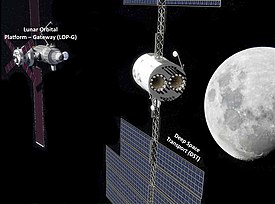
Back Deep Space Transport Catalan Deep Space Transport German Deep Space Transport Spanish ترابری فضایی عمیق Persian Deep Space Transport French Deep Space Transport Italian 深宇宙輸送機 Japanese Deep Space Transport Polish Deep Space Transport Portuguese Deep Space Transport Ukrainian
 DST would comprise an Orion spacecraft and a propelled habitation module | |
| Mission type | Crewed Mars orbiter |
|---|---|
| Operator | NASA |
| Mission duration | 1–3 years |
| Spacecraft properties | |
| Launch mass | 100 metric tons[1][2][3] |
| BOL mass | Habitat: 48 tons (includes 21 tons Habitat with 26.5 tons cargo[1]) Electric propulsion system: 24 tons[1] Chemical propellant: 16 tons[1] |
| Start of mission | |
| Launch date | Suggested shakedown: 2027[4] Potential Mars launch: 2037[5] |
| Rocket | Space Launch System (SLS) |
| Launch site | LC-39B, Kennedy Space Center |
| Transponders | |
| Band | Dual: radio and laser comm[4][6] |
| Bandwidth | Ka band[6] |
The Deep Space Transport (DST), also called Mars Transit Vehicle,[6] is a crewed interplanetary spacecraft concept by NASA to support science exploration missions to Mars of up to 1,000 days.[4][2][7] It would be composed of two elements: an Orion capsule and a propelled habitation module.[3] As of late 2019, the DST is still a concept to be studied, and NASA has not officially proposed the project in an annual U.S. federal government budget cycle.[5][8][9] The DST vehicle would depart and return from the Lunar Gateway to be serviced and reused for a new Mars mission.[2][10][11]
- ^ a b c d Deep Space Transport (DST) and Mars Mission Architecture. (PDF) John Connolly. NASA Mars Study Capability Team. Published: October 17, 2017.
- ^ a b c Neel V. Patel. NASA Unveils the Keys to Getting Astronauts to Mars and Beyond. The Inverse. April 4, 2017.
- ^ a b Michelle Rucker, John Connolly. Deep Space Gateway – Enabling Missions to Mars – Shakedown Cruise Simulating Key Segments of Mars Orbital Mission. Mars Study Capability Team (2018). NASA.
- ^ a b c Eric Berger. Finally, some details about how NASA actually plans to get to Mars. ARS Technica. March 28, 2017.
- ^ a b Jeff Foust. Independent report concludes 2033 human Mars mission is not feasible. Space News. 18 April 2019.
- ^ a b c Cite error: The named reference
Free 2017was invoked but never defined (see the help page). - ^ Deep Space Transport approaches the Deep Space Gateway. The Planetary Society.
- ^ Philip Sloss. Cislunar station gets thumbs up, new name in President’s budget request. NASA Spaceflight. March 16, 2018.
- ^ Philip Sloss. NASA evaluates EM-2 launch options for Deep Space Gateway PPE. NASA Spaceflight. December 4, 2017.
- ^ Hambleton, Kathryn (March 28, 2017). "Deep Space Gateway to Open Opportunities for Distant Destinations". NASA. Archived from the original on September 27, 2017. Retrieved March 31, 2017.
- ^ Gatens, Robyn; Crusan, Jason. "Cislunar Habitation & Environmental Control & Life Support System" (PDF). NASA. Archived from the original (PDF) on March 31, 2017. Retrieved March 31, 2017.
© MMXXIII Rich X Search. We shall prevail. All rights reserved. Rich X Search